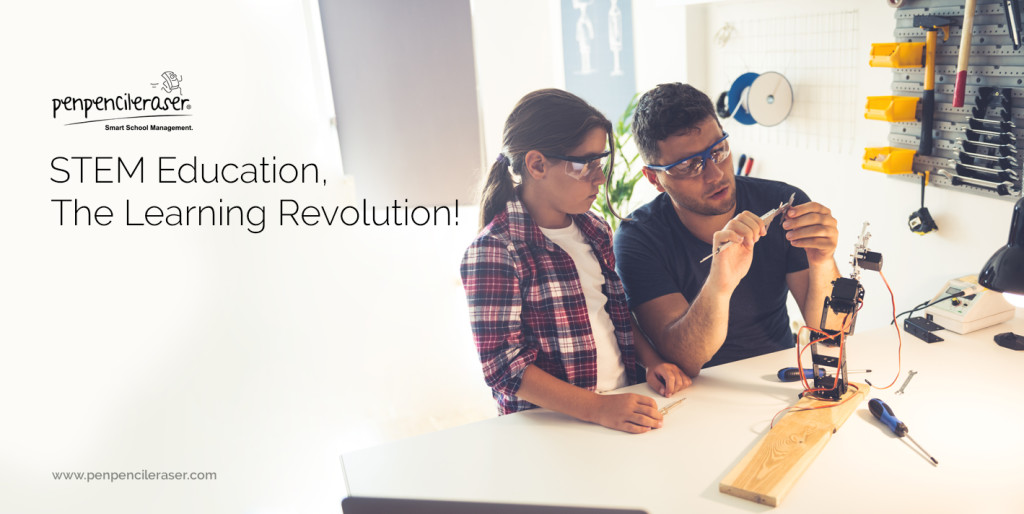STEM-based education or curriculum is popular and gaining momentum among the education and academic communities across the globe in the recent years. So let us explore what is special about them, and are they new in the education communities and systems?
Well, the answer is yes and no, if we look closely at the acronym of STEM, we get Science, Technology, Engineering, and Mathematics. We define STEM, as a way of educating and creating exposure in children to the world of STEM-related fields (Science, Technology, Engineering) with real-world problem-solution scenarios, and not just by the conventional theory-and-experiment education followed in schools worldwide.
If we see the existence of the STEM, the answer will be, it is one of a kind. Something new that is dictated by the time and era we live in. If we look closely at the education, it is used as a means of educating and creating exposure to the student to a more sustaining education.
Where the science and technology are at its height, innovation pops up every second, by this way the student gets ample exposure and abundant opportunity to explore the various fields in STEM and are likely motivated to pursue the STEM-based profession.
Inevitability of STEM Education
The main necessity for the STEM education is preparing the student for a sustaining career, with respect to time and current trend. As mentioned earlier STEM education is one of the kinds which is dictated by time and era.
If we look at the Renaissance era, the importance is given to art and literature, where the printing press first emerged, here the growth of the art and architecture excelled. When we consider the era of 40’s and end of 50’s we could see the development of system/curriculum for education framed, and here the Knitting for girls and the carpentry for the boys existed.
Then followed by workshop classes, focusing on mechanical skills, this followed by the computer era, where the home-brew computers emerged. Here the computer literacy co-existed, which it is the basic for a sustaining career then and now, in due course, it became a part of the curriculum since computers are playing a crucial part in our lives.
How to Incorporate STEM
As the recent study and analysis of researchers showed the best method of incorporating STEM education into current curriculum should be done at the elementary level. It is always best to introduce them as generic as possible, rather than as separate STEM concepts. In this process, their creativity of examining, exploring things and finding solutions are seeded in their minds.
Again, if we take a closer look at introducing STEM, it is suggested that best time to introduce is at a preschool level, where they would be learning the skill of exploring things. Much like Hands-on Attractive Exploration! Where the mere imagination and hands are put to the labor in order to stack pebbles, will form a basic masonry craftsmanship.
Understanding the Scenarios
Fundamentally, the scenarios involved in STEM are in the first hand the problem needs to be identified and then the solution to be sorted out from the available possibilities. The solution must be thought of based on the economy, time-critical dependency, build challenge.
The execution will be the end process of the result that will mostly be of physical computing related solution in the academic community, since it helps in the exploring and interacting visually and will be easy to grasp.
Physical computing is a type of computing where the interactions performed by the computers are brought to reality, rather than being hypothetical. The sensing or the input are fed through buttons or sensor, then the actuator/output is in the form of interaction, such as articulation through light or sound or automation or computer/remote server input or the combination of all. The physical computing involves the use of some form of task-specific computer, like the micro-controller (Arduino/ NodeMCU) which are limited in processing power, or microprocessors (Beagle Bone/Raspberry Pi/Orange Pi) having dedicated processor and higher memory and capable of multitasking. The cost and the usability vary, based on the performance and speed.
Example 1: Automated Pedal Bin
Situation: The pedal bin is a type of dustbin, with a normally closed lid. And has a pedal at the front bottom, which should be pressed to pivot the closed lid at the top. The encountered problem is that the opening and closing of the lid should be automated.
Solution: Investigation is conducted on the working of the pedal bin as a first step. The student studies the mechanical structure first and tries to come up with a semi-permanent solution. The students would then seek a mechanical actuator which is controlled by electronics. The electronics can be replaced by single chip computers since they are designed for doing a single task and in order to avoid the complexity of circuit design. With this, the working of the pedal bin is been semi-automated.
To make it fully automated, a sensor is required to sense the environment and based on the reading by the sensor, the computer makes the decision to activate the actuator or not. The sensor can range from cheap IR sensor to full-scale industrial precision sensor. Now, the usage of such sensors is planned based on the economy and complexity and lastly precision.
Example 2: Plant Watering System
Situation: Now we hop into a little more complex problem of ‘Automated Plant Watering System’. Here the problem is plant growing medium require manual watering which should be automated.
Solution: The setup is focused on simplicity and academic viewpoint. Here the first thing to know is the soil moisture. The soil moisture should be the determinant of the level of water content. The precision is based on the cost and processing power. For the academic purpose, we stick to moisture resistance sensor, where the output is given as voltage. Here the student is made to take field tests on soil moisture at which the coded logic for the automatic watering unit should be activated. The soil moisture gives output in terms of voltage, the 5V output for the presence high moisture content followed by 0v for low moisture content.
So, it is gets simplified as the computer is programmed to listen for input from the moisture sensor and when certain moisture data condition is met, it activates the dc motor pump which waters the plant up to certain time as the constraints are met.
The real and practical exposure is encouraged in the STEM learning and proves to be the best curriculum for the overall development of the child.

